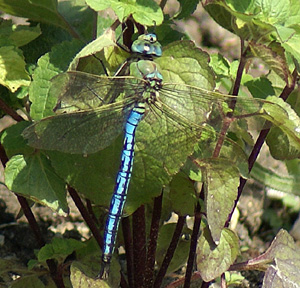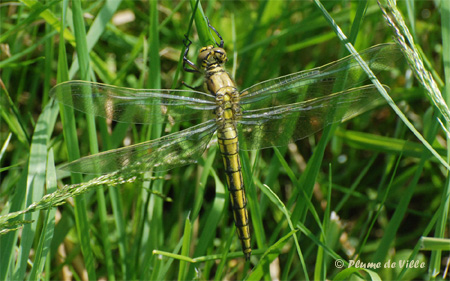Plume de Ville
Libellules.
°°°°°°°°°°°°°°°°°°°°°°° °
June 2009 -2-
June 11th
Likable
"blue".
Black-tailedSkimmer.
[Orthetrum cancellatum - Libellulidae - Orthetrum]
(Orthétrum réticulé).
Here is one which likes to pose.
When this male does not crossing its space at high speed as a blue
dart, it
likes to alight on promontories or on rocks or lanes. It accept be
approached
closely without flinching.
I have not met yet a female this year, so I invited this one from
August of
last year, laying. It was perhaps a relative... it is the same place.
Its wings
do not have a stain at the base and its pterostigmas are black and
slender.
(Ph. 030609)
June 12th
Scarce blue.
Scarce
chaser.
[Libellula fulva --Libellulidae Libellula] (libellule
fauve).
Another "blue" male.
Bases of the hindwings with dark triangles, similar to the broad-bodied
chaser,
but smaller. The fore wings have a little dark streak.
Gray-blue eyes.
It also likes the promontories in plain view.
Its female
is yellow-orange (fawn). I have not yet found this season.
This scarce
chaser below, is different, it presents an additional dark patch on the
wings
tip (apex). This spot is not always present in males, as evidenced in
the above
photos. These dragonflies were photographed at different locations. The
"parisian"
I have met have no stains. In Seine et Marne I saw both: with and
without spots
at the wings apex. I wonder the reasons for that, I haven't yet found
any
information on this topic.
A
funny little
detail.
A beautiful fur. And... one leg around the neck!
Probably an old individual, completely blue.
(Ph. 220509 - 020609 - 030609)
These three
"big blue" may be confused. So I put all of them abreast.
In order of appearance:
Broad-bodied
chaser,
Scarce
chaser,
Black-tailed skimmer.
Four well
defined spots
A
triangle on hind wing,
No
spots.
on the two
pairs of wings.
a
single streak on the fore one.

June 15th
Still some scarce
chasers. They aged.
All blue, with beautiful blue eyes. No more brown eyes as when they
were
younger.
There are fewer. Funny, a lot with the first pair of legs placed behind
the
eyes.
It's almost the end of their blue races.
These males will fight always guarding preciously their territory.
A little later, an emperor dragonfly scours his stretch of water, well
positioned in the middle and sometimes flying very high in the trees
before
returning.
A
female
banded demoiselle waited, quite alone. The little large red
damselflies, much
less plentiful are also lonely, no more tandems. Besides a large number
of azure
damselflies.
(Ph. 120609 Bois de Vincennes)
June 18th
The Emperor
dragonfly. [Anax imperator]
The male patrols his territory. Vast territory, it has reserved an entire elongated
body of water that it patrols from the center, seldom approaching the bank.
Almost no hover, ample flight, powerful, at almost constant speed.
There are hard
clashes over the water, endless fights. The Anax spends its energy without
restrain.
Finally alight... for a few seconds. It
has defended its territory for a long time, its wings very damaged.

As it did
not posed again, here is one that decided to alight after a very long waiting
in June of last year.
(Ph Paris. 260608)
And yet,
some photos of laying. The abdomen of the female seems very black now.
The Brilliant
emerald. [Somatochlora metallica] (Chlorocordulie
métallique).
We can say that we are acquainted since long time (this one is a male).
I saw it often fly over his territory, and tried vainly to catch it in photos.
It flies fast almost at water level and changes direction constantly. These are
not the placid Corduliidae!
This time,
in the sun, it finally allowed be photographed hovering long-time enough. I
even had the impression that it was by curiosity that it came close enough to
the bank.
His abdomen has a bulb-like bulge, and then abruptly narrows to grow again
gradually.
Its green
eyes, shine beautifully in the sun.
It is a shimmering green arrow of 5cm.
(Ph. Seine et Marne 160609)
June19th
The Black-lined
skimmer.
[Orthetrum cancellatum] (Orthétrum réticulé)
When young, it is yellow with black stripes.
This one alighted in the grass of a meadow, far from water. If he had not flown
off briefly, it would have remained invisible in the vegetation. We must not lose
it of view during its flight to spot where it lands.



